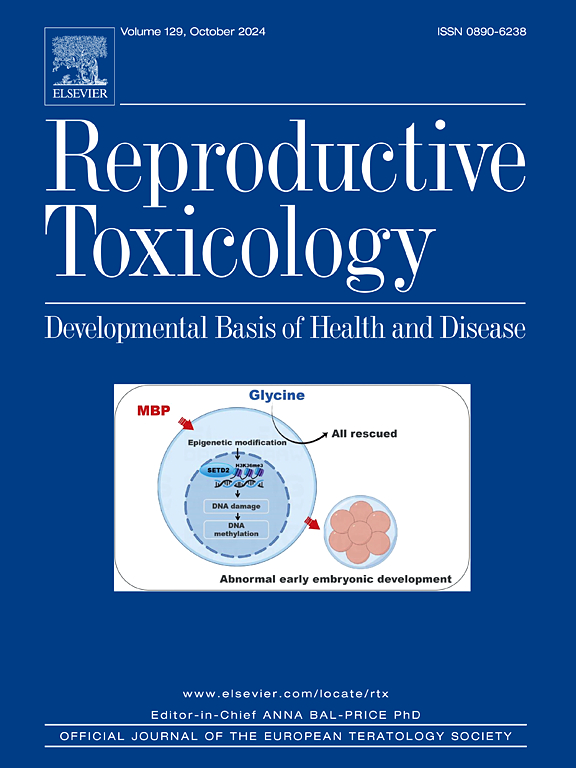慢性不可预测的应激暴露通过调节生殖细胞连接动力学和Nrf2/HO-1/IKKβ/NF-κB通路破坏睾丸功能。
IF 3.3
4区 医学
Q2 REPRODUCTIVE BIOLOGY
引用次数: 0
摘要
压力的不可预测性使人们很难理解它与男性不育的关系。在这项研究中,我们研究了暴露于慢性不可预测应激(CUS)后雄性小鼠睾丸生殖细胞和连接动力学。成年Parkes雄性小鼠暴露于CUS 35天(一个完整的生精周期),每天以间歇性和不可预测的方式施加随机应激源(约束应激、水剥夺、食物剥夺、灯光闪烁、湿被褥、笼子摇晃或笼子倾斜)一次,以避免连续几天重复相同的刺激。通过强迫游泳试验和悬尾试验观察到,CUS暴露导致小鼠行为改变。CUS通过降低甾体生成标志物(SF-1、StAR、3β-HSD和17β-HSD)抑制睾酮生物合成。它还导致氧化炎症和凋亡标志物的改变,包括睾丸中LPO、Caspase-3、IKKβ和NF-κB的增加,以及Nrf2、HO-1、SOD和过氧化氢酶的降低。CUS暴露减少1C和4C生殖细胞数量,降低生殖细胞比例(1C:2C、4C:2C和4C: s期),损害精子发育。CUS通过降低睾丸中Stra8、SYCP3和Piwil1的表达来破坏减数分裂起始、染色体突触和生殖细胞维持。它还对血睾丸屏障标志物,如ZO-1和connexin43产生不利影响。这些变化导致睾丸组织形态改变,减少每日精子产量,破坏生殖细胞动力学。研究结果表明,CUS可抑制甾体生成,干扰Nrf2/HO-1/IKKβ/NF-κB氧化炎症通路。这导致生殖细胞动力学破坏,血睾丸屏障完整性受损,组织形态学改变,精子产量减少,共同导致睾丸功能障碍。本文章由计算机程序翻译,如有差异,请以英文原文为准。
Chronic unpredictable stress exposure disrupts testicular function by modulating germ cell-junctional dynamics and Nrf2/HO-1/IKKβ/NF-κB pathway
The unpredictable nature of stress complicates understanding its relationship with male infertility. In this study, we investigated testicular germ cell and junctional dynamics in male mice following exposure to chronic unpredictable stress (CUS). Adult Parkes male mice were exposed to CUS for 35 days (one complete spermatogenic cycle), with a random stressor (restraint stress, water deprivation, food deprivation, light flashing, wet bedding, cage shaking, or cage tilting) applied once per day in an intermittent and unpredictable manner to avoid repeating the same stimulus on consecutive days. CUS exposure caused behavioral alterations in mice, as observed through the forced swim test and the tail suspension test. CUS inhibited testosterone biosynthesis by decreasing steroidogenic markers (SF-1, StAR, 3β-HSD, and 17β-HSD). It also resulted in altered oxido-inflammatory and apoptotic markers, including increased LPO, Caspase-3, IKKβ, and NF-κB, along with decreased Nrf2, HO-1, SOD, and catalase in the testis. CUS exposure reduced 1 C and 4 C germ cell populations and decreased germ cell ratios (1 C:2 C, 4 C:2 C, and 4 C:S-phase), impairing sperm development. CUS disrupted meiosis initiation, chromosomal synapsis, and germ cell maintenance by reducing Stra8, SYCP3, and Piwil1 expression in the testis. It also adversely affected blood-testis barrier markers, such as ZO-1 and connexin43. These changes led to altered testicular histomorphology, reduced daily sperm production, and disrupted germ cell dynamics. The findings suggest that CUS inhibits steroidogenesis and perturbs the Nrf2/HO-1/IKKβ/NF-κB oxido-inflammatory pathway. This leads to disrupted germ cell dynamics, compromised blood-testis barrier integrity, altered histomorphology, and reduced sperm production, collectively resulting in testicular dysfunction.
求助全文
通过发布文献求助,成功后即可免费获取论文全文。
去求助
来源期刊

Reproductive toxicology
生物-毒理学
CiteScore
6.50
自引率
3.00%
发文量
131
审稿时长
45 days
期刊介绍:
Drawing from a large number of disciplines, Reproductive Toxicology publishes timely, original research on the influence of chemical and physical agents on reproduction. Written by and for obstetricians, pediatricians, embryologists, teratologists, geneticists, toxicologists, andrologists, and others interested in detecting potential reproductive hazards, the journal is a forum for communication among researchers and practitioners. Articles focus on the application of in vitro, animal and clinical research to the practice of clinical medicine.
All aspects of reproduction are within the scope of Reproductive Toxicology, including the formation and maturation of male and female gametes, sexual function, the events surrounding the fusion of gametes and the development of the fertilized ovum, nourishment and transport of the conceptus within the genital tract, implantation, embryogenesis, intrauterine growth, placentation and placental function, parturition, lactation and neonatal survival. Adverse reproductive effects in males will be considered as significant as adverse effects occurring in females. To provide a balanced presentation of approaches, equal emphasis will be given to clinical and animal or in vitro work. Typical end points that will be studied by contributors include infertility, sexual dysfunction, spontaneous abortion, malformations, abnormal histogenesis, stillbirth, intrauterine growth retardation, prematurity, behavioral abnormalities, and perinatal mortality.
 求助内容:
求助内容: 应助结果提醒方式:
应助结果提醒方式:


